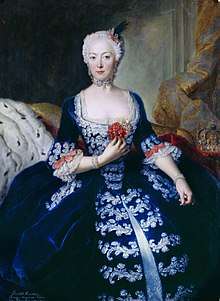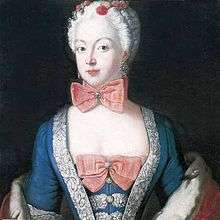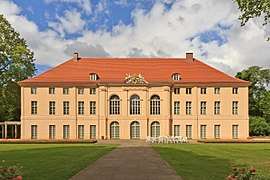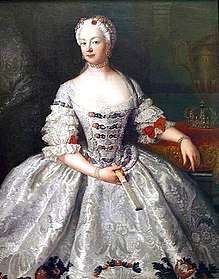Elisabeth Christine of Brunswick-Wolfenbüttel-Bevern
| Elisabeth Christine | |
|---|---|
 Portrait by Antoine Pesne, c. 1739 | |
| Tenure | 31 May 1740 – 17 August 1786 |
| Born |
8 November 1715 Schloss Bevern, Germany |
| Died |
13 January 1797 (aged 81) Stadtschloss, Berlin, Prussia |
| Burial | Berlin Cathedral |
| Spouse | Frederick II of Prussia |
| House | Brunswick-Bevern |
| Father | Ferdinand Albert II, Duke of Brunswick-Wolfenbüttel |
| Mother | Antoinette of Brunswick-Wolfenbüttel |
| Religion | Lutheranism |
Elisabeth Christine of Brunswick-Wolfenbüttel-Bevern (8 November 1715 – 13 January 1797) was Queen of Prussia from 1740 to 1786 as the spouse of Frederick the Great. By birth, she was a Duchess of Brunswick-Wolfenbüttel. She was also the longest-serving queen of Prussia.
Early life
Elisabeth Christine was born the daughter of Duke Ferdinand Albert II and Duchess Antoinette of Brunswick-Wolfenbüttel.
In 1733, Crown Prince Frederick of Prussia, having failed in his attempt to flee from his father's tyrannical regime, was ordered to marry a daughter of the Duke of Brunswick-Lüneburg.[1] Elisabeth Christine was the niece of Holy Roman Emperor Charles VI's wife Elisabeth Christine of Brunswick-Wolfenbüttel; the match had thus been arranged by the Austrian court in the hopes of securing influence over Prussia for another generation.[1]


Crown Princess
On 12 June 1733, Elisabeth Christine married Frederick at her father's summer palace, Schloss Salzdahlum in Wolfenbüttel, Germany. On their wedding night, Frederick spent a reluctant hour with his new wife and then walked about outside for the rest of the night. Due to the circumstances behind their betrothal, Frederick was well known to have resented the marriage from the very beginning.[1] He had only agreed to marry Elisabeth after his failed attempt to escape from his father's tyrannical regime. The King had thereafter ordered Frederick to marry the daughter of Duke Ferdinand Albrecht of Brunswick-Wolfenbuttel, and Frederick had submitted to his father's will in order to regain his freedom.
Thus, the position of Elisabeth Christine, who was only seventeen on her marriage, at the Berlin Court, was difficult from the beginning, as the only support that she could count on was the King's. Her father-in-law, Frederick William I, had indeed remained attached to his daughter-in-law until his death and was particularly fond of her piety, which did nothing to endear her husband. However, Frederick was shrewd enough to recognise the opportunity his wife provided to improve his own relationship with his father, and systematically used her to gain favours from him. During the first year of their marriage, Frederick was garrisoned in Ruppin, while Elisabeth lived in Berlin at the king's court, and he showered her with letters asking for travel permits, money, etc., from the King or even demanding that she run up debts in Brunswick to pay for his expenses. This pattern continued even after the couple moved to the palace in Rheinsberg in 1736.
There, Frederick was allowed to maintain a court of his own for the first time, and there the couple's marital life seems to have been as normal as it would ever become—Elisabeth Christine later recalled the Rheinsberg years as the "happiest of her life". However, the basis for this relationship, which was characterised by admiration, or even love, on Elisabeth's side, and cool calculation on Frederick's, disappeared with his accession to the throne in 1740.
Queen consort
When Frederick's father died and he acceded to the throne of Prussia as Frederick II in 1740, he and Elisabeth Christine began to live separately. It should be mentioned that throughout his life, Frederick did not show any sexual interest in women, and the only woman whom he considered a close friend was his older sister, Wilhelmine. He had no known affairs with women, and presided over a very spartan, almost military court, where women rarely appeared and never held any influence. Tradition has it that Elisabeth Christine could not understand Frederick's indifference and that she had an unrequited love for her spouse. Her mother-in-law felt sorry for her because of this and often invited her to her residence.

Frederick the Great did not care for ceremonial court life and representation, which he associated with the undue influence of women upon state affairs, such as the influence of the royal mistresses in France, and left most of the posts in his own court vacant and thereby did not possess much of a court at Potsdam.[2] During the first years of his reign, he did somewhat revive the court life, but after Sanssouci palace in Potsdam was completed in 1747, he spent his life more and more isolated in Sanssouci in the summer and the Potsdam royal residence in winter, and only appeared at the official royal court in Berlin at special occasions such as birthdays of members of the royal house and visits of foreign princes.
Despite his personal contempt for representational court life, however, he realized its importance in the system of state, and therefore did not abolish court life in Prussia, but rather left virtually all representational duties to his wife.[3] Queen Elisabeth Christine therefore had a very visible and official role as queen of Prussia: during the first seventeen years of his reign, she shared the representational duties of the court with her mother-in-law, and after the death of the dowager queen in 1757, she handled them alone. When he became king, Frederick gave Elisabeth Christine her own summer residence, Schönhausen Palace in Berlin, and redecorated her apartments in the Berlin Royal Palace, appointing a large court for her to assist her in upholding the court routine. In Berlin, Elisabeth Christine received foreign princes, ambassadors and generals, and hosted official court events such as royal birthdays and weddings. During summers at Schönhausen, she entertained the royal family and the Prussian aristocracy with concerts and dinners. and hosted a circle of Lutheran theologians such as Büschning, Spaldning and Zöllner.[4] At both residences, she presided at the weekly reception days, courtage, which were the only occasions were the entire Prussian royal court assembled as a whole during the reign of Frederick the Great.[5]
She was described in 1779 by the English tourist Dr. Moore: "The Queen has one Court-day in the week, when the Princes, nobility, and foreign ambassadors wait upon her, at five o' clock. After she has made the tour of the circle, and said a few words to each, she seats herself at the card-table. The Queen has her own table, and each of the Princesses has one. The rest of the company shows itself a moment at each of these card tables, and then the attendance for the day is over, and they walk in the garden, or form other card-tables in the other rooms, as it pleases them, and return to Berlin at dusk. Sometimes the Queen invites a good many of them to supper, and then they remain till midnight. These are the only assemblies where one meets the Berlin ladies in summer."[6] Despite the fact that Frederick entrusted the role of representation to her, he did not always give her the funds necessary to play this role, and it caused surprise to foreigners that the king did not give the queen funds necessary to entertain more lavishly, as her court reception were the only one in Prussia; as the king became more spartan over the years, the receptions of the queen become more underfunded, Charpentier once joking: "The Queen must have a grand gala tonight; I saw an old lamp lighted on the staircase as I passed!"[6]
The king himself only very rarely attended any of the court events, while the queen was always present. He visited the birthday celebration of the queen only twice between 1741 and 1762, was often absent at royal weddings, such as for example the wedding of Prince Henry in 1752 and Prince Frederick William in 1765, where she also acted as his representative: he was often absent even at his own official birthday celebration, where she normally received birthday congratulations in his place, and when he did attend, he normally only appeared very swiftly and then left again.[7] When he did appear in Berlin, he normally did not represent at his own apartment, but merely visited the queen's reception in her apartment.[8] Frederick was often absent even at important functions, such as the state visit of the Russian Grand Duke in 1776. While he on rare occasions participated in Berlin court life, he never visited her court at Schönhausen, nor was she ever invited to Sanssouci. Though Elisabeth Christine was never involved in any politics and lacked any influence whatsoever, her receptions were always well attended as she hosted the only court life taking place in Prussia at the time, which made it an important social center and a place to meet important people.[9]
During the Seven Years' War, the king was permanently absent from the capital for six years. He had left the queen no formal responsibility or instructions, but she became the symbol of Prussian resilience in the capital during the crisis, and was greeted by cheering crowds when she appeared in public.[10] When Berlin was threatened in 1757, it was she who took the responsibility for the royal house and court, and ordered for it to be evacuated to Magdeburg.[11] She was able to return to Berlin in 1758, but was again forced to evacuate in 1760. It was on the first of these occasions that she saw Sanssouci for the first time. In 1763, when Frederick saw his wife for the first time in six years, he only commented: "Madame has grown quite fat." Despite his lack of interest in her person, Frederick demanded that Elisabeth Christine be respected in her capacity as a queen and her task in upholding the representational court life he avoided, but his separation from her and her subsequent lack of influence, in combination with her timid personality, aroused pity and made it hard for her to receive respect: on one occasion, for example, the opera singers refused to appear at her concert, and she was forced to ask Fredrick to demand that she be treated with respect.[12]

Elisabeth Christine was interested in literature, and authored several works. After the death of her friend Sophie Caroline von Camas in 1766, she published a French translation of Le Chrétien dans la Solitude,[13] she continued to publish translations under the pseudonym "Constance", such as the Réflexions sur l'etat des affaires publiques en 1778,[13] which aroused public patriotism during the War of Bavarian Succession. Her works were included in the library of the king, who also presented her with his own writings.[6] She introduced silk cultivation to Prussia, and she was involved in charity, to which she contributed 23,000 thalers out of her allowance of 40,000 thalers. She said of herself: "God has graciously kept me, so that I need not reproach myself for any action by which any person has with my knowledge been hurt."[14]
Queen Dowager
Elisabeth Christine became a queen dowager upon the death of Frederick the Great in 17 August 1786. She was not present at the death of her spouse and had at that time not seen him since January, but she was given public sympathy for his death because of the popularity she enjoyed among the public to all of whom, according to Spalding, she was "so dear in her affliction."[6] She commented the death of Frederick to his successor Frederick William with the words: "Frederic the Great would have been adored for his great qualities had he been only a private individual; all great Princes might take example from him; he reigned like the true father of his people. He was a true friend himself, but he had many false ones, who, under the mask of attachment, separated him from those who were devoted to him heart and soul ; yet these deceitful persons caused him sorrow when he discovered their falsehood, and he rendered justice to his true friends without bringing them into notice, lest he should expose them to persecution. He was generous and beneficent, he maintained his position without hauteur, and in society he was like a private gentleman".[6]
In the will of Frederick the Great, Elisabeth Christine was secured not only the continuation of her usual income, but also an additional 10,000 thalers annually, wine, firewood, game, residence in the royal palaces of her choice, and a directive that his successor and nephew Fredrick William always treat her with respect due to her position.[6]
As a queen dowager, Elisabeth Christine had an active and important role in public life. Due to her long experience in handling the representational life of the reign of Frederick the Great, "the Queen Dowager, who, by her circumspection and natural dignity, was of more importance than the Queen regnant", was often consulted in matters of etiquette.[6] She was a popular participator in the social life of high society and frequently attended weddings and baptisms of the members of nobility, and she was a center in the family life of the royal house, corresponding with them while they were away, particularly with her former foster daughter Princess Frederica Charlotte of Prussia.
She is noted to have acted as an intermediary and interceded in favor of supplicants, and regularly spent more than half her income in charity: she particularly supported the French émigrés community in Berlin. Upon her death, Spalding commented: "her memory will always be blessed as a touching example of the noblest mental qualities, the most enlightened and lively piety, and the most wonderfully active benevolence."[6]
Ancestors
References
- 1 2 3 Biskup, p. 304.
- ↑ Clarissa Campbell Orr: Queenship in Europe 1660-1815: The Role of the Consort. Cambridge University Press (2004)
- ↑ Clarissa Campbell Orr: Queenship in Europe 1660-1815: The Role of the Consort. Cambridge University Press (2004)
- ↑ Clarissa Campbell Orr: Queenship in Europe 1660-1815: The Role of the Consort. Cambridge University Press (2004)
- ↑ Clarissa Campbell Orr: Queenship in Europe 1660-1815: The Role of the Consort. Cambridge University Press (2004)
- 1 2 3 4 5 6 7 8 Atkinson, Emma Willsher: Memoirs of the queens of Prussia, London : W. Kent
- ↑ Clarissa Campbell Orr: Queenship in Europe 1660-1815: The Role of the Consort. Cambridge University Press (2004)
- ↑ Clarissa Campbell Orr: Queenship in Europe 1660-1815: The Role of the Consort. Cambridge University Press (2004)
- ↑ Clarissa Campbell Orr: Queenship in Europe 1660-1815: The Role of the Consort. Cambridge University Press (2004)
- ↑ Clarissa Campbell Orr: Queenship in Europe 1660-1815: The Role of the Consort. Cambridge University Press (2004)
- ↑ Clarissa Campbell Orr: Queenship in Europe 1660-1815: The Role of the Consort. Cambridge University Press (2004)
- ↑ Clarissa Campbell Orr: Queenship in Europe 1660-1815: The Role of the Consort. Cambridge University Press (2004)
- 1 2 Adlersfeld-Ballestrem, Eufemia von (2018-01-08). Elisabeth Christine, Königin von Preußen, Herzogin von Braunschweig-Lüneburg. Biografie einer Verkannten: In Briefen und Selbstzeugnissen (in German). Diplomica Verlag. ISBN 9783963370236.
- ↑ Reiners, Ludwig (Swedish): Fredrik den store (Fredrick the Great). Bokindustri Aktiebolag (1956) Stockholm
- ↑ Genealogie ascendante jusqu'au quatrieme degre inclusivement de tous les Rois et Princes de maisons souveraines de l'Europe actuellement vivans [Genealogy up to the fourth degree inclusive of all the Kings and Princes of sovereign houses of Europe currently living] (in French). Bourdeaux: Frederic Guillaume Birnstiel. 1768. p. 51.
Sources
- Biskup, Thomas. (2004). "The Hidden Queen: Elisabeth Christine of Prussia and Hohenzollern Queenship in the Eighteenth Century" in Queenship in Europe 1660-1815: The Role of the Consort. Clarissa Campbell Orr (ed.). Cambridge University Press. ISBN 0-521-81422-7.
- Hans-Henning Grote (2005) Schloss Wolfenbüttel. Residenz der Herzöge zu Braunschweig und Lüneburg. S. 228. ISBN 3-937664-32-7.
- Paul Noack: Elisabeth Christine und Friedrich der Große. Ein Frauenleben in Preußen. 2. Auflage. Klett-Cotta, Stuttgart 2002, S. 185, ISBN 3-608-94292-0
- Reiners, Ludwig (Swedish): Fredrik den store (Fredrick the Great). Bokindustri Aktiebolag (1956) Stockholm
External links
| Wikimedia Commons has media related to Elisabeth Christine von Braunschweig-Bevern. |
Elisabeth Christine of Brunswick-Wolfenbüttel-Bevern Born: 8 November 1715 Died: 13 January 1797 | ||
| German royalty | ||
|---|---|---|
| Preceded by Sophia Dorothea of Hanover |
Queen consort in Prussia 31 May 1740 – 19 February 1772 |
Title abolished elevated to Queen consort of Prussia |
| New title | Queen consort of Prussia 19 February 1772 - 17 August 1786 |
Succeeded by Frederika Louisa of Hesse-Darmstadt |